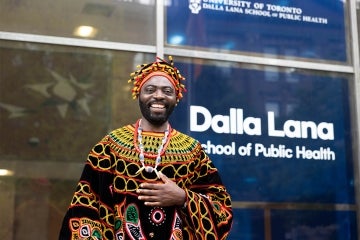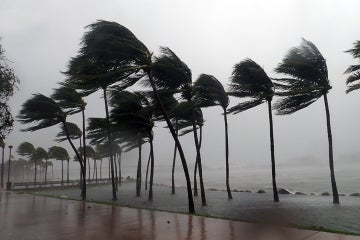An accordion superstar, self-driving cars: Our favourite U of T moments from the 2016-2017 academic year

Published: July 4, 2017
With the last grad crossing the stage in Convocation Hall, the 2016-2017 academic year came to a close.
We’re looking back at the incredible accomplishments made by University of Toronto faculty, students and alumni who made an impact this year in Toronto and across the world.
Standout students
Research
Tech royalty
Campus life
U of T in the city
Going global
Standout students
We begin with Sandro Young of the department of electrical & computer engineering. He finished the year with the highest marks of any undergraduate across U of T’s three campuses. (And no, he didn’t spend every waking hour in Robarts Library.)
A 4.0 GPA isn’t the only way to impress. At just 20-years-old, U of T undergrad Joseph Moysuik led a team of scientists that determined where exactly an ancient marine creatures known as hyoliths belonged on the tree of life. His research earned a write-up in The New York Times.
If you thought 20 was young, here's someone even younger making headlines at U of T. Xiaoxiao (Maddy) Zhang, who turned 15 in January, is likely the youngest student in the history of the Faculty of Applied Science & Engineering.
While some students set their sights on the stars, others aimed for Mars. U of T engineering students completed a project with advisers from NASA – the undergrads came up with a way to make products like food, pharmaceuticals and fuel using elements of the Martian atmosphere.
Convocation brought smiles and tears. Precilla Veigas, who was diagnosed with a terminal cancer halfway through her PhD, received her degree from the University of Toronto's Institute of Medical Science in a special graduation ceremony in May. “I believed in miracles and I was ready to fight,” she said.
This list would be incomplete without Michael Bridge. He learned to play accordion when he was 5 and graduated with a master’s degree in music performance. He appeared on Breakfast Television and Metro News – with his accordion. Don’t miss his rendition of Leonard Cohen’s Hallelujah but keep some Kleenex handy.
Thought-provoking research
The importance of scientific research was brought to the forefront with a long-anticipated review of federal science funding, chaired by U of T President Emeritus David Naylor. The Fundamental Science Review made a number of recommendations, including increased support for early-career researchers and a funding boost. Conversation surrounding the report is still continuing with nearly 200 concerned researchers gathering in Toronto recently to devise a strategy on how to turn the recommendations into reality.
Researchers at U of T gained insight into the creation of life on earth. They studied creatures living deep beneath the earth’s surface, and they helped an international team trace the origins of mankind hundreds of thousands of years into the past, with surprising results – our human ancestors may have originated in Europe, not Africa.
The cyber sleuths at Citizen Lab at U of T's Munk School of Global Affairs uncovered a massive spyware campaign in Mexico, cyber espionage linked to Russia, governments turning to commercial spyware to intimidate dissidents in the UAE, a phishing campaign in Egypt and Chinese social media censorship this year – findings that led to extensive international coverage, including by the New York Times. A film adaptation of Ron Deibert's 2013 book Black Code premiered last fall at the Toronto International Film Festival.
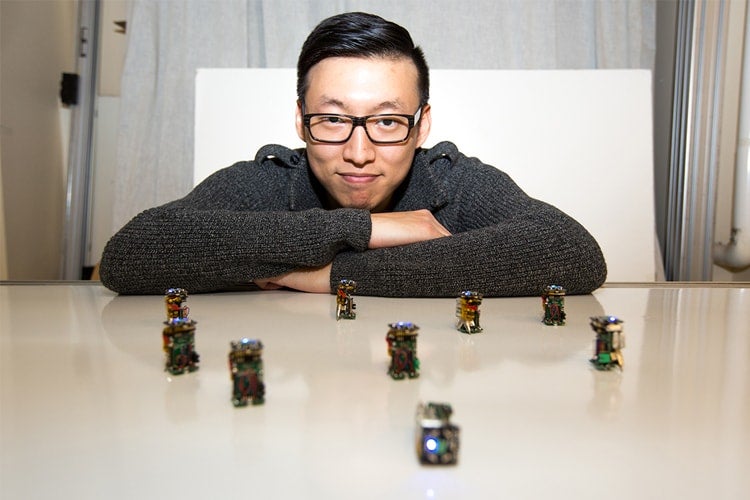
Engineering PhD student Justin Kim has built nine robots not much larger than a thumb that exhibit “swarm intelligence” (photo by Johnny Guatto)
U of T students and faculty also harnessed the power of technology to save lives. PhD engineering student Justin Kim’s tiny robots could one day help rescue earthquake survivors or explore other planets while scientists at the Donnelly Centre are using deep learning to help reveal what makes cells healthy and what goes wrong in disease.
Some scientists are even finding inspiration from the tiniest members of the animal kingdom – flies. Andrew Mason, an associate professor of biology at U of T Scarborough, is studying the ormia ochracea’s incredible hearing to help solve some of the biggest problems with hearing aid technology.
And what are the odds of this? Married U of T professors Lei Sun and Radu Craiu won the same prestigious statistics prize one year apart.
Tech royalty
It became abundantly clear this year that U of T is a global leader in artificial intelligence and an innovation powerhouse.
The launch of the Vector Institute – aimed at attracting and maintaining AI talent in Toronto – kept campus abuzz with excitement this past spring.
Geoffrey Hinton, considered the “godfather of deep learning,” who is a University Professor Emeritus in computer science at U of T and vice-president engineering fellow at Google, will serve as Vector's chief scientific adviser. U of T Associate Professor and self-driving car expert Raquel Urtasun is one of its co-founders.
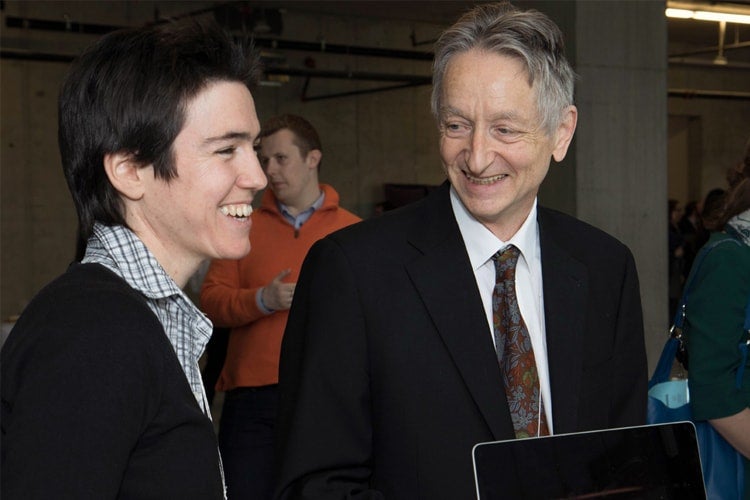
AI leaders Raquel Urtasun and Geoffrey Hinton
International companies are now setting up shop in Toronto to take advantage of U of T’s AI talent.
Urtasun will be joining the team at Uber, which is opening its first international research lab in Toronto.
This year also saw U of T AI legal research startup ROSS, which made it big in Silicon Valley, return to Toronto to open up a research and development lab.
While startups are returning home, U of T’s Creative Destruction Lab accelerator is expanding across the country. It’s already set up shop at the University of British Columbia and will soon appear in business schools in Calgary, Montreal and Halifax.
Campus life
Women made up 40.1 per cent of students in first-year engineering classes, the highest share in university engineering programs province-wide. Meanwhile, Bruce Kidd, principal of U of T Scarborough and former Olympian, saluted a move by the Ontario government to ease women’s path into sports.
U of T students led the charge for more diversity.
They hosted the university’s first powwow in two decades at the Athletic Centre. And in June, black students held a special graduation ceremony for their peers to add to the convocation experience. “To see our Black grads celebrated with their family, friends and faculty to support them was really beautiful,” said Nasma Ahmed, one of the organizers.
In another first for the university, U of T began teaching the ancient Ethiopic language of Ge’ez thanks to donations from the local community, History Professor Michael Gervers and Grammy-winning singer The Weeknd. A U of T alumnus, Ravi Gukathasan, CEO of Digital Specialty Chemicals Ltd. in Scarborough, also gave a historic donation of $2 million to U of T Scarborough to support a new Tamil studies program. “I want UTSC to be a star when it comes to the Sri Lankan Tamil diaspora, its culture, its language, its perspective in the world,” says Gukathasan. “We have the biggest Tamil diaspora in the world in Scarborough. They need to be proud.”
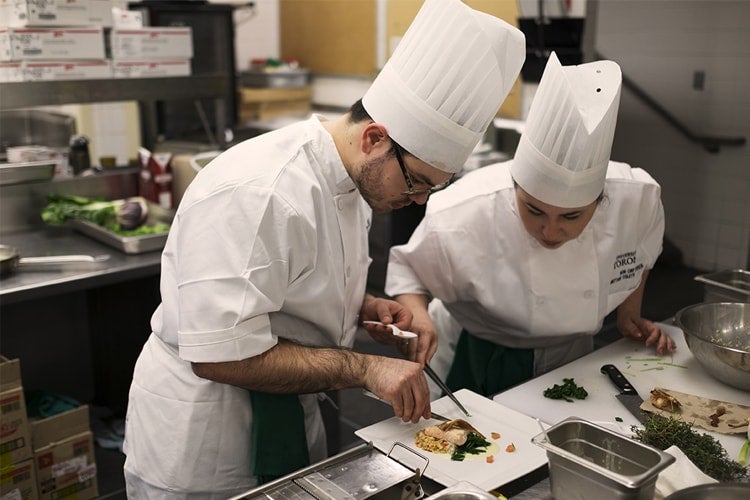
Felipe Branco and Brettany Colette plate a dish during a practice session for Iron Chef 2017 (photo by Geoffrey Vendeville)
It was also a year for ripening taste buds. For the first time, U of T hosted the inter-university Iron Chef culinary competition, finishing second. Over at U of T Scarborough, Professor Dan Bender gave his students food for thought, asking them to cook curries from different eras for their midterm in “Edible History.”
Here's a stunning fact: students learned this year that even in university, there’s room for fun.
U of T students showed off video games that they designed at the Level Up Showcase. In the first-ever Entrepreneurship@UofT Week, students pitched, networked and demoed at the Startup Showcase.
U of T in the city
From our pop star exports to our sports teams making the playoffs, this year all eyes are on Toronto – and our scientific community is no exception.
In December, pharmaceutical giant Bayer AG and venture capital firm Versant Ventures announced a $225 million investment to help turn stem cell science into real-world treatments in Toronto. The investors said they were attracted to the city because of U of T’s regenerative medicine “dream team” of Gordon Keller and Michael Laflamme.
“We go where the science is best,” said Jerel Davis, a managing director at Versant Ventures.
This spring, the university invited the public to explore its architectural gems including the newly opened One Spadina building on its downtown Toronto campus during Doors Open, and helped kids and families to learn about science in fun and interactive ways during Science Rendezvous.
Meanwhile, U of T’s army of city builders remain hard at work, finding ways to improve urban life in Toronto and globally.
U of T News has been telling their stories in a new video series called On Location. Check out the first two episodes – one on U of T's debut at Winter Stations, the annual design competition where teams from all over the world build art installations across Toronto's east-end beaches, and the U of T architecture professor who is an advocate for laneway housing.
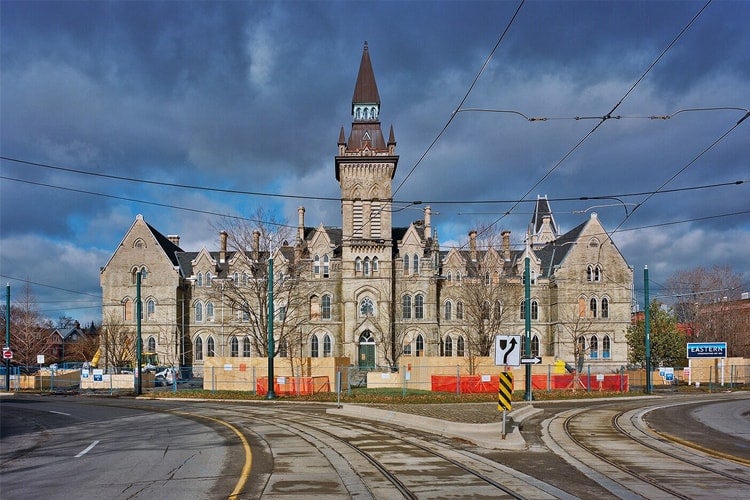
One Spadina was in the spotlight at this year's Doors Open (photo by Peter MacCallum)
So how can we improve our cities? University Professor and director of Rotman School of Management’s Martin Prosperity Institute (MPI) Richard Florida says it starts with tackling inequality. His new book, The New Urban Crisis, explores how the back-to-the-city movement has led to rising housing prices, economic disparity and the decline of middle-class neighbourhoods. He and his team have launched a massive online open course (MOOC) to teach the public about cities.
But perhaps we can also look to the future to ensure we’re on the right path. That was the aim of a Toronto Life feature that imagines the city in 50 years, using data collected by U of T's Martin Prosperity Institute and interviews with U of T’s cities experts including Mark Fox and Shauna Brail.
Meanwhile at the St. George campus, work has begun to raise funds for the Landmark project, which hopes to make the campus more pedestrian friendly and accessible. U of T Mississauga is also looking ahead with a vision plan for the future of its campus.
Going global
Even as Europe and the United States became more isolationist with Brexit and U.S. President Donald Trump, U of T opened itself up to students from around the globe.
University officials kept an eye on U.S. travel restrictions, and faculties and departments organized town halls, and supported international students and scholars who were affected by America's new travel policy. Khaled Almailaji, a Syrian doctor stranded by the U.S. travel ban, was invited to continue his studies in public health at U of T while the university covers his tuition.
International students seemed keener than ever to study in Canada and at U of T. From Australia to Zimbabwe, they applied to the university in record numbers. There was a flurry of interest from American students, especially after the presidential election.
U of T held events in the U.S. and India this year to give students a glimpse of the university and Toronto. Saturday Night Live producer Lorne Michaels, who graduated from U of T in 1966, spoke to prospective students in New York. “When I went (to U of T), it was very, very conducive to learning,” he said. “Also winter helps because it narrows your choices and you’re perfectly happy to be reading a book when it’s cold and snowy.”
The university welcomed the first generation of Lester B. Pearson international scholars, an award named after the former prime minister, Nobel Laureate and U of T alumnus. At the same time, U of T said goodbye to the first graduating class of MasterCard Foundation Scholars.
Where do U of T graduate students go after convocation? U of T News checked in with former PhD and postdoctoral students. One founded a child language lab at New York University, another started a nanoenergy lab at Johns Hopkins and a third designs aerospace software simulating how materials bend, break or vibrate.
Selfie Moments
While convocation with this year's popular frame was a huge hit with grads and their families, it was Prime Minister Justin Trudeau's appearance for a Rotman event last month that drew the most snaps.
The event, co-organized with the New York Times and MPI, marked the first major sit-down interview with Trudeau on Canadian foreign policy following Canadian Foreign Affairs Minister (and U of T area member of Parliament) Chrystia Freeland's June 6 speech to the House of Commons about Canada’s changing role and position in geo-politics.
Students lined up outside Desautels Hall and cheered as Trudeau entered. As he exited, they flocked to the back of the room for selfies.

